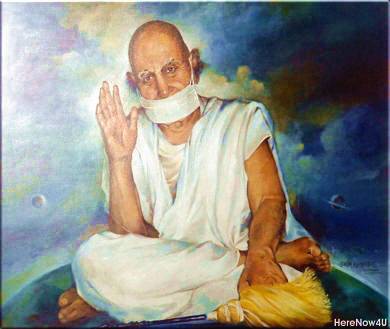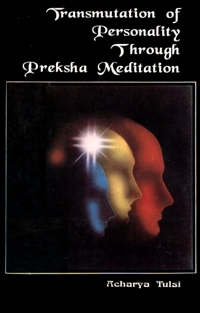
Is this technique of preksha dhyana a creation of your own imagination or has it a solid basis reflecting some ancient tradition?
Dhyana-sadhana cannot be mere flight of imagination because it is a practical discipline. Where there is practice, the aspect of imagination becomes secondary. The aspect of imagination is an emotional one. Poetry. may grow out of it, but it does not lead to practice. Preksha dhyana is a matter of practice. It has certain principles on which the practice is based. But the theory occupies a secondary place; the chief thing is the practice itself. The exercise is more related to practice. Without regular practice, the exercise would be futile. In the course of practice, the sadhak reaches a point where he may be able to establish a theory. Every exercise is anchor in theory and new theories are also evolved.
In the Jain tradition, there are enough theories of meditation, but no practical applications thereof. In the absence of practice, the theories are not properly understood. The principles of preksha dhyana are intelligible only in the perspective of practice. In the Acharang, Sthanang, and Uttaradhyyana Sutras is to be found an original and powerful basis for the system of preksha. Through the discovery, application and examination of these grounds, it has been established that there has been a systematic, uninterrupted tradition of meditation in the jain religion, but without the touchstone of practice, none of the theories of meditation could establish an independent identity.
Some Jain munis and scholars have already concluded that no technique of meditation is to be found in the Jain Agamas. With a view to changing this wrong conception, it was decided to reassess the available data. Yuvacharya Mahaprajna was specially directed to implement this decision. For years he conducted certain experiments on himself. He studied other techniques of meditation, appraised them, went into their theoretical aspects and practised them. Thus was laid the foundation for the practice of meditation or direct experiencing. Afterwards, a comparative study was made of the elements of meditation found in the Agamas, Acharang, Sthanang and Uttaradhyyana etc. and experiments were conducted. Those experiments were very successful. Success creates faith and faith in turn strengthens conception. It is on the basis of sturdy concepts that a new technique is formulated and developed. Such is the story of the evolution of the technique of preksha dhyana. On the whole we can say neither is this technique the product of our imagination, nor have we inherited it. The technique has been perfected on the basis of the data found in the Agamas and by correlating the Agmic concepts with direct experiencing, and it is being progressively developed.
Does this technique of preksha dhyana belong to the Terapanth Dharam Sangh? Is it accepted in the Jain tradition alone or is it, like the anuvrata, a universal system?
Meditation is the ground work of experience where differences of sect or tradition do not arise. Still, the means employed to acquire that background may be isolated. From this point of view, the method of preksha dhyana can be related to the Jain tradition. The paramount objective of the system of preksha dhyana is veetaragta, i.e. total freedom from attachment and aversion. The starting point of preksha is the abatement of attachment and aversion or their partial enfeeblement. The ultimate end is their total extinction. Attachment and aversion - these are the two elements which distort our consciousness. Unless that distortion is done away with or at least lessened, the condition of dhyana does not arise. The whole pilgrimage between the starting point and the ultimate end of dhyana is the pilgrimage of abatement or waning of attachment and aversion. There can be many hindrances therein. Because, the greater the bondage of attachment and aversion, the stronger is the play of passions. As long as passions are dominant, the mind cannot be at rest. A restless mind is neither fit for meditation nor can it progress in the direction of veetaragta. From this point of view, it seems logical to assert that in the jain tradition, a system of meditation is a process of becoming a veetarag, i.e. of achieving freedom from affections. In my opinion that should be the objective of every system of meditation. A system of meditation with a comprehensive aim in view, is bound to be complete in itself and useful for every individual.
Constant practice is required to make the conception of dhyana -sadhana sharp and clear. If that practice is in the direction of veetaragta, one can reach the destination easily. But the greatest difficulty that one experiences is in finding out what precisely is the method of subduing or ending attachment and aversion. What is the precise way which leads to the assuagement or decay of attraction and malice?
There is a special method of treating this problem and that is the way of pure knowledge and pure intuition. Only knowing, only seeing. The maturer the practice of only knowing and only seeing, the deeper and more durable is the state of meditation. In short, it is said that the whole process of meditation is the process of only knowing and seeing. In the beginning, merely knowing and seeing is the prime thing. In the ultimate stages, there is complete absence of attachment and aversion. All that obscures knowledge and intuition stands dissolved. And then there is the consummation of dhyana - pure knowledge and pure intuition. Before this, there is a gap between the soul and the transcendental knowledge and intuition. During this interval, the condition of the soul does not remain natural; its possibilities do not wholly project themselves. The soul keeps quivering on account of pleasant and unpleasant sensations. Knowing it does not really know; seeing it does not really see. Because in that imperfect condition, its knowledge and intuition are incomplete, undeveloped. Although, while practising meditation, the sadhak becomes a mere spectator and he concentrates only on seeing and knowing, but his knowledge and intuition is not yet perfect; there remains some hindrance in between. This hindrance dissolves in the moment of realization of the state of veetaragta, i.e. the state of total freedom from passions and affections. Knowledge and intuition become manifest and unobscured. Resolute practice of pure knowledge and pure intuition in the early stages culminates in full knowledge and full intuition.
On the way to veetragta - the condition of total freedom from passions and affections - the stages of elementary practice are: relaxation (kayotsarg), breath-perception, breath-control, slowness of breathing, perception of changes occurring in the body, cleansing of the special psychic centres present in the body, and the perception of psychic colours for the purification of passions, etc. This process brings about a transformation both within and without. On the level of the body, there occurs a change in the endocrine secretions, and on the mental level, a change in character takes place. These physical and mental changes affect the soul. Even before one reaches perfection, one experiences a kind of self-fulfilment.
Did you prescribe this whole method at the very beginning, or was it stabilized only after many changes had been introduced as a result of experimentation and experience?
How can a new technique be stabilized at once? Particularly where experimentation and experiencing predominate, no method can be confirmed on the basis of preconceptions. Although, a recognized method of sadhana requires stability to be able to inspire deep faith in it, this can only be accomplished as a result of experimentation and experience. The system of preksha dhyana, too, is the consummation of many years of practice and experimentation. The wealth of experience grows with every exercise, which strengthens the groundwork for the next exercise. In my opinion; there should not be any kind of rigidity with respect to dhyana. A stereotyped technique is liable to become a hindrance to future progress. So, keeping open the field of experimentation and experience, one should gradually move forward through the medium of one's adopted technique.
 Acharya Tulsi
Acharya Tulsi
